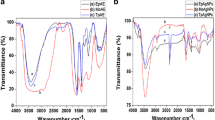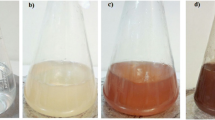Abstract
Due to the controlled release of Ag+, silver nanoparticles (AgNPs) not only display excellent anticancer activity but also possess cytotoxicity on normal cells. Up to now, no efficient method has been found to eliminate the side effect. In this study, AgNPs with different morphologies were synthesized and some main factors, i.e., the seed amount, CTAB concentration and temperature were discussed. Histidine (His) was applied to modify three kinds of AgNPs (near nanospheres, short nanorods and long nanorods) prepared by the above controlled synthesis, and the bioactivity of the modified AgNPs on cancer and normal cells was investigated. The results showed that the morphology and particle size of AgNPs had strong dependency on the quantity of seeds and reaction temperature except for CTAB concentration. IR spectra showed that His molecules had linked to AgNPs by coordination between AgNPs and C–N group of the imidazolyl in His. The bioactivity experiments in vitro showed that the cytotoxicity of His-modified AgNPs on HL7702 cells was effectively reduced and the anti-tumor activity against MCF-7 cells was not influenced obviously. The results supported that the His-modified AgNPs possess less cytotoxicity and higher targeting anticancer activity and thus the silver nanomaterials modified by His displayed potential applications for cancer therapies. We also suggested that the possible mechanism on the reduction of the cytotoxicity was that His-modified AgNPs could target cancer cells to decrease the cytotoxicity but affect a little on the viability of normal cells.






Similar content being viewed by others
References
Tao LL, Lou YJ, Zhao Y, Hao MM, Yang YB, Xiao Y, Tsang YH, Li JB (2018) Silver nanoparticle-decorated graphene oxide for surface-enhanced Raman scattering detection and optical limiting applications. J Mater Sci 53:573–580. https://doi.org/10.1007/s10853-017-1501-z
Zeng XP, Wang Q, Wang H, Yang YJ (2017) Catalytically active silver nanoparticles loaded in the lumen of halloysite nanotubes via electrostatic interactions. J Mater Sci 52:8391–8400. https://doi.org/10.1007/s10853-017-1073-y
De Matteis V, Rizzello L, Di Bello MP, Rinaldi R (2017) One-step synthesis, toxicity assessment and degradation in tumoral pH environment of SiO2@Ag core/shell nanoparticles. J Nanopart Res 19:196
Elbaz NM, Ziko L, Siam R, Mamdouh W (2016) Core-shell silver/polymeric nanoparticles-based combinatorial therapy against breast cancer in-vitro. Sci Rep 6:30729
Ganta S, Devalapally H, Shahiwala A, Amiji M (2008) A review of stimuli-responsive nanocarriers for drug and gene delivery. J Controll Release 126:187–204
Adepu S, Khandelwal M (2018) Broad-spectrum antimicrobial activity of bacterial cellulose silver nanocomposites with sustained release. J Mater Sci 53:1596–1609. https://doi.org/10.1007/s10853-017-1638-9
Kumar M, Bala R, Gondil VS, Pandey SK, Chhibber S, Jain DVS, Sharma RK, Wangoo N (2017) Combating food pathogens using sodium benzoate functionalized silver nanoparticles: synthesis, characterization and antimicrobial evaluation. J Mater Sci 52:8568–8575. https://doi.org/10.1007/s10853-017-1072-z
Hu G, Jin W, Chen Q, Cai Y, Zhu Q, Zhang W (2016) Antibacterial activity of silver nanoparticles with different morphologies as well as their possible antibacterial mechanism. Appl Phys Mater Sci Process 122:874
Guo DW, Zhu LY, Huang ZH, Zhou HX, Ge Y, Ma WJ, Wu J, Zhang XY, Zhou XF, Zhang Y, Zhao Y, Gu N (2013) Anti-leukemia activity of PVP-coated silver nanoparticles via generation of reactive oxygen species and release of silver ions. Biomaterials 34:7884–7894
Gurunathan S, Han JW, Dayem AA, Eppakayala V, Park JH, Cho SG, Lee KJ, Kim JH (2013) Green synthesis of anisotropic silver nanoparticles and its potential cytotoxicity in human breast cancer cells (MCF-7). J Ind Eng Chem 19:1600–1605
Zhang W, Hu G, Zhang W, Qiao X, Wu K, Chen Q, Cai Y (2014) Surfactant-directed synthesis of silver nanorods and characteristic spectral changes occurred by their morphology evolution. Phys E Low Dimens Syst Nanostruct 64:211–217
Chen SH, Carroll DL (2002) Synthesis and characterization of truncated triangular silver nanoplates. Nano Lett 2:1003–1007
Murphy CJ, Jana NR (2002) Controlling the aspect ratio of inorganic nanorods and nanowires. Adv Mater 14:80–82
Jana NR, Gearheart L, Murphy CJ (2001) Wet chemical synthesis of silver nanorods and nanowires of controllable aspect ratio. Chem Commun 7:617–618
Jana NR (2004) Shape effect in nanoparticle self-assembly. Angew Chem Int Ed 43:1536–1540
Lee GJ, Shin SI, Kim YC, Oh SG (2004) Preparation of silver nanorods through the control of temperature and pH of reaction medium. Mater Chem Phys 84:197–204
Zhang W, Zhang W, Qiao X, Qiu X, Chen Q, Cai Y (2014) Controllable preparation of silver nanostructures and the effects of acidity-basicity of the reaction system. Sci Adv Mater 6:304–311
Nangmenyi G, Li XA, Mehrabi S, Mintz E, Economy J (2011) Silver-modified iron oxide nanoparticle impregnated fiberglass for disinfection of bacteria and viruses in water. Mater Lett 65:1191–1193
Govindaraju K, Krishnamoorthy K, Alsagaby SA, Singaravelu G, Premanathan M (2015) Green synthesis of silver nanoparticles for selective toxicity towards cancer cells. IET Nanobiotechnol 9:325–330
Zhang XF, Liu ZG, Shen W, Gurunathan S (2016) Silver nanoparticles: synthesis, characterization, properties, applications, and therapeutic approaches. Int J Mol Sci 17:34
Zhong YA, Meng FH, Deng C, Zhong ZY (2014) Ligand-directed active tumor-targeting polymeric nanoparticles for cancer chemotherapy. Biomacromolecules 15:1955–1969
Awasthi KK, Awasthi A, Verma R, Kumar N, Roy P, Awasthi K, John PJ (2015) Cytotoxicity, genotoxicity and alteration of cellular antioxidant enzymes in silver nanoparticles exposed CHO cells. RSC Adv 5:34927–34935
Ivask A, Juganson K, Bondarenko O, Mortimer M, Aruoja V, Kasemets K, Blinova I, Heinlaan M, Slaveykova V, Kahru A (2014) Mechanisms of toxic action of Ag, ZnO and CuO nanoparticles to selected ecotoxicological test organisms and mammalian cells in vitro: A comparative review. Nanotoxicology 8:57–71
Eom HJ, Chatterjee N, Lee J, Choi J (2014) Integrated mRNA and micro RNA profiling reveals epigenetic mechanism of differential sensitivity of Jurkat T cells to AgNPs and Ag ions. Toxicol Lett 229:311–318
Liang JM, Zeng F, Zhang M, Pan ZZ, Chen YZ, Zeng YN, Xu Y, Xu Q, Huang YZ (2015) Green synthesis of hyaluronic acid-based silver nanoparticles and their enhanced delivery to CD44(+) cancer cells. RSC Adv 5:43733–43740
Li J, You J, Dai Y, Shi M, Han C, Xu K (2014) Gadolinium oxide nanoparticles and aptamer-functionalized silver nanoclusters-based multimodal molecular imaging nanoprobe for optical/magnetic resonance cancer cell imaging. Anal Chem 86:11306–11311
Zhang ZH, Liu CH, Bai JH, Wu CC, Xiao Y, Li YH, Zheng J, Yang RH, Tan WH (2015) Silver nanoparticle gated, mesoporous silica coated gold nanorods (AuNR@MS@AgNPs): low premature release and multifunctional cancer theranostic platform. ACS Appl Mater Interfaces 7:6211–6219
Shannahan JH, Podila R, Aldossari AA, Emerson H, Powell BA, Ke PC, Rao AM, Brown JM (2015) Formation of a protein corona on silver nanoparticles mediates cellular toxicity via scavenger receptors. Toxicol Sci 143:136–146
Jegatheeswaran S, Selvam S, Ramkumar VS, Sundrarajan M (2016) Facile green synthesis of silver doped fluor-hydroxyapatite/beta-cyclodextrin nanocomposite in the dual acting fluorine-containing ionic liquid medium for bone substitute applications. Appl Surf Sci 371:468–478
Kelestemur S, Altunbek M, Culha M (2017) Influence of EDC/NHS coupling chemistry on stability and cytotoxicity of ZnO nanoparticles modified with proteins. Appl Surf Sci 403:455–463
Zhang W, Qiao X, Chen Q, Cai Y, Chen H (2012) The influence of synthesis condition and aging process of silver nanocrystals on the formation of silver nanorods. Appl Surf Sci 258:5909–5913
Liu X, He TJ, Liu FC, Chen DM (2005) Preparation and spectroscopic studies of silver nanorod colloids. Chin J Chem Phys 18:81–86
Jana NR, Gearheart L, Murphy CJ (2001) Wet chemical synthesis of high aspect ratio cylindrical gold nanorods. J Phys Chem B 105:4065–4067
El-Sayed MA (2001) Some interesting properties of metals confined in time and nanometer space of different shapes. Acc Chem Res 34:257–264
Tornblom M, Henriksson U (1997) Effect of solubilization of aliphatic hydrocarbons on size and shape of rodlike C16TABr micelles studied by 2H NMR relaxation. J Phys Chem B 101:6028–6035
Al-Thabaiti SA, Obaid AY, Hussain S, Khan Z (2015) Shape-directing role of cetyltrimethylammonium bromide on the morphology of extracellular synthesis of silver nanoparticles. Arab J Chem 8:538–544
Bergstrom LM (2016) Second CMC in surfactant micellar systems. Curr Opin Colloid Interface Sci 22:46–50
And SM, Benshaul A (2001) Molecular theory of the sphere-to-rod transition and the second CMC in aqueous micellar solutions. J Phys Chem B 105:630–640
Shi Y, Luo HQ, Li NB (2011) Determination of the critical premicelle concentration, first critical micelle concentration and second critical micelle concentration of surfactants by resonance Rayleigh scattering method without any probe. Spectroc Acta Pt A Mol Biomol Spectr 78:1403–1407
Sui ZM, Chen X, Wang LY, Xu LM, Zhuang WC, Chai YC, Yang CJ (2006) Capping effect of CTAB on positively charged Ag nanoparticles. Phys E Low Dimens Syst Nanostruct 33:308–314
Li H, Tripp CP (2004) Use of infrared bands of the surfactant headgroup to identify mixed surfactant structures adsorbed on Titania. J Phys Chem B 108:18318–18326
Kumar S, Rai AK, Rai SB, Rai DK (2010) Infrared and Raman spectra of Histidine : an ab initio DFT calculations of Histidine molecule and its different protonated forms. Indian J Phys 84:563–573
Hasegawa K, T-a O, Noguchi T (2000) Vibrational spectra and ab initio DFT calculations of 4-methylimidazole and its different protonation forms: Infrared and Raman markers of the protonation state of a histidine side chain. J Phys Chem B 104:4253–4265
Noguchi T, Inoue Y, Tang X-S (1999) Structure of a histidine ligand in the photosynthetic oxygen-evolving complex as studied by light-induced Fourier transform infrared difference spectroscopy. Biochemistry 38:10187–10195
Chen Z, Zhang X, Cao H, Huang Y (2013) Chitosan-capped silver nanoparticles as a highly selective colorimetric probe for visual detection of aromatic ortho-trihydroxy phenols. Analyst 138:2343–2349
Sanader Z, Mitric R, Bonacic-Koutecky V, Bellina B, Antoine R, Dugourd P (2014) The nature of electronic excitations at the metal-bioorganic interface illustrated on histidine-silver hybrids. Phys Chem Chem Phys 16:1257–1261
Shi JP, Sun X, Zou XY, Zhang HW (2014) Amino acid-dependent transformations of citrate-coated silver nanoparticles: Impact on morphology, stability and toxicity. Toxicol Lett 229:17–24
Hu G, Cai Y, Tu Z, Luo J, Qiao X, Chen Q, Zhang W (2015) Reducing the cytotoxicity while improving the anticancer activity of silver nanoparticles through alpha-tocopherol succinate modification. Rsc Adv 5:82050–82055
Lee T-Y, Liu M-S, Huang L-J, Lue S-I, Lin L-C, Kwan A-L, Yang R-C (2013) Bioenergetic failure correlates with autophagy and apoptosis in rat liver following silver nanoparticle intraperitoneal administration. Part Fibre Toxicol 10:1–13
Meng F, Zhong Y, Cheng R, Deng C, Zhong Z (2014) pH-sensitive polymeric nanoparticles for tumor-targeting doxorubicin delivery: concept and recent advances. Nanomed Nanotechnol Biol Med 9:487–499
Wojtkowiak JW, Gillies RJ (2012) Autophagy on acid. Autophagy 8:1688–1689
Mirolo L, Schmidt T, Eckhardt S, Meuwly M, Fromm KM (2013) pH-dependent coordination of AgI Ions by histidine: Experiment, theory, and a model for SilE. Chem A Eur J 19:1754–1761
Acknowledgements
The Project was supported by the National Natural Science Foundation of China (Grant No. 81071254) and the Natural Science Foundation of Guangdong Province, China (Grant No. 10451051501004706). We would like to thank Prof. Zhengchao Tu and his research team (High Throughput Drug Screening Center, Guangzhou Institutes of Biomedicine and Health, Chinese Academy of Sciences) for the antibacterial test.
Author information
Authors and Affiliations
Corresponding author
Rights and permissions
About this article
Cite this article
Hu, G., Liang, G., Zhang, W. et al. Silver nanoparticles with low cytotoxicity: controlled synthesis and surface modification with histidine. J Mater Sci 53, 4768–4780 (2018). https://doi.org/10.1007/s10853-017-1940-6
Received:
Accepted:
Published:
Issue Date:
DOI: https://doi.org/10.1007/s10853-017-1940-6




